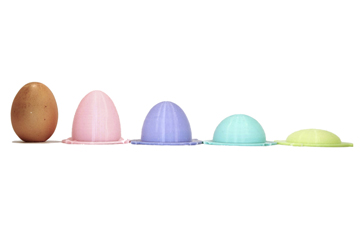Sharper Curve, Stronger Egg

(ISNS) -- Breaking an egg is a lot easier along its side than at its tip, and scientists can now say exactly why -- and by how much.
This new information could help bioengineers better understand the biological structure of egg-shaped cells -- and how those cells might respond to medications.
Two different research teams independently developed a way to derive how strong an egg-like object is based on its shape and what it's made of.
Egg-shaped objects, or ovoids, are common throughout nature, and can be seen in chicken eggs, the organelles of cells and the outer shells of some viruses. Up to now, finding the rigidity of any size of egg-shaped shell had to either be approximated with estimates based on the properties of spheres and cylinders, or measured directly using specialized lab equipment.
It's well known that the strongest part of an ovoid is at its narrow tip. The sharper the curve of an ovoid, the stronger and more rigid it is at its tip.
"What's new is that we kind of tried to study a class of shapes," said Dominic Vella, a mathematician at the University of Oxford, in the U.K., and lead author of one of the papers.
In the past, researchers studying the structural properties of ovoids had to approximate their calculations using equations for other shapes for simplicity's sake.
Sign up for the Live Science daily newsletter now
Get the world’s most fascinating discoveries delivered straight to your inbox.
Massachusetts Institute of Technology engineer Arnaud Lazarus, and lead author of the second paper, said that the two teams’ work could be used to infer the properties of an ovoid without breaking it open.
"Our formula is that if you apply a force on that shell, and it deforms, you can predict how thick the shell is," said Lazarus.
Conversely, a researcher can deduce the cell’s internal pressure by knowing the thickness and material properties of a cell’s outer casing. This is important when developing new treatments because if a cell is under a lot of internal pressure, it might be harder for a new medicine to seep inside, but could be more prone to bursting.
"The field of cellular mechanics is always searching for theoretical models through which to extract material parameters from experiments," said K.C. Huang, a bioengineer at Stanford University who did not work on the research. "Beyond important fundamental questions of biological material properties, these studies may also find applications in the design of thin shell geometries with specific mechanical behaviors such as differential rigidity and buckling."
Reis said that their work could also be extended to a variety of applications in addition to biomechanics.
"If you know the material properties and the geometry of your shell quite well, and if you are sure that there are not too many imperfections such as micro-cracks in it, the results predicted by our formula … are indeed very accurate," said Pedro Reis a mechanical engineer at MIT, who worked with Lazarus.
Ironically these micro-cracks limit the formula's usefulness for chicken eggs. Though the perfect shape and seemingly smooth, eggs have a lot of tiny imperfections along the surface of their shells, and are prone to break at the weakest spots. A hard-boiled egg would be more in line with what their formula can easily predict.
"We didn't set out to understand the shape of an egg, it was just an inspiration," said Reis.
Though the two teams arrived at nearly identical conclusions, they took complimentary approaches to reach them. Lazarus’s team used a 3-D printer to make molds for silicone casts of four different ovoid egg shapes. Using a precision laboratory scale, the team pressed down on the tip of the mold, and measured how much each "egg" pushed back. The team ran the experiment several times using different molds with different densities and shapes to get a general understanding of how the shape of an egg affects its strength.
"You can tune that stiffness, you can tune that rigidity by playing with the shape," said Reis.
Vella's team started from the ground up, using computer models of egg shapes. They built an idealized eggshell inside a computer-modeling program, and ran simulations based on different possible shapes, shell materials and internal pressures.
"We tried to base that more mathematically on equations that we know govern elastic shells," said Vella.
"Thin shells are everywhere," said Yves Pomeau, a mathematics professor emeritus at Arizona University. "I expect applications in biology to measure small scale elasticity, and perhaps in other fields as well."
The two papers are both set to be published in an upcoming issue of Physical Review Letters.
Mike Lucibella is a contributing writer to Inside Science News Service.
Inside Science News Service is supported by the American Institute of Physics.









